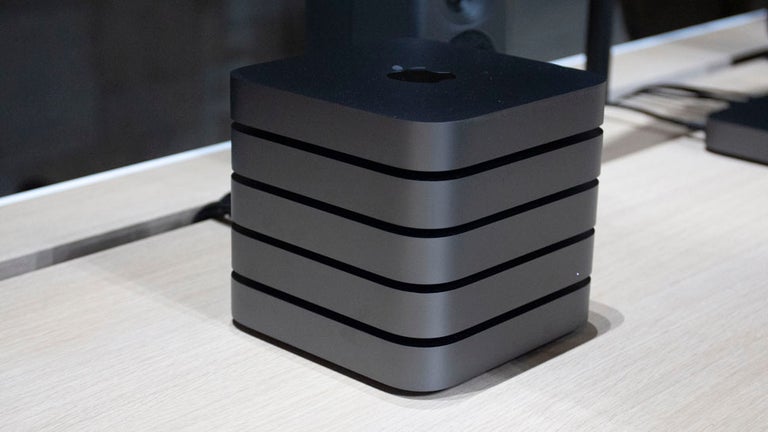
[ad_1]
Apple’s second press blitz of the fall delivered details on a bunch of new devices. But the company also made some announcements on the environmental front that are generating buzz and raising questions, particularly regarding the recycled materials some of its 2018 product line will use.
Specifically, Apple announced that the 2018 models of its MacBook Air and its back-from-the-dead Mac Mini are being built with a 100 per cent recycled aluminium case, using a custom alloy that incorporates excess aluminium scavenged from the manufacturing process. Apple claims these changes, along with the incorporation of post-consumer recycled plastic into the Mac Mini, have reduced the two products’ overall carbon footprints by nearly 50 per cent, and that the new MacBook Air is the “greenest Mac ever.”
It’s the latest in Apple’s ongoing effort to fashion itself as a company environmentally-conscious consumers can feel good buying from. Last spring, Apple announced that all its data centres, stores, and offices are now powered by renewable energy, and it debuted a second-generation version of an iPhone recycling robot that will somehow factor into the company’s ambitious long-term goal, first announced in 2017, of ending the mining of virgin materials altogether.
Devices made with “fine shavings of recaptured aluminium,” per the company, give us a more concrete glimpse of what a post-mining Apple could look like—or at least, an Apple that spends less time contracting others to blast the Earth for ore and more mining its own supply chain. But like Apple’s other recent environmental claims, it comes with important caveats and leaves plenty of open questions.
We don’t, for instance, know how much aluminium the company will continue to mine and refine for its other products, including its new iPad Pro and a range of legacy devices that use the metal for their enclosure. We don’t know how environmentally intensive its new alloy production process is, and it isn’t clear what numbers Apple did (and didn’t) include in its maths to figure that recycled aluminium will cut the new devices’ carbon footprints in half. When reached for comment, Apple sent us quotes from its latest publicly-available environmental responsibility report that explain how the company seeks to recover aluminium both from manufacturing and from dead phones using its recycling robots.
We do know that aluminium is a big part of Apple’s environmental footprint—accounting for a full quarter of the company’s carbon emissions from manufacturing, per Apple’s own maths—and that the company has made reducing this particular impact a priority. Aluminium is extracted from bauxite ore (which is mined in a wasteful and ecologically-destructive process) before being smelted into a pure compound. Apple is now attempting to mitigate this energy-intensive process by sourcing more metal smelted using hydroelectric power and less using fossil fuels. Recovering more metal from the manufacturing process so that there’s less need to mine the Earth for it should shave that footprint down further.
Josh Lepawsky, a geographer at Memorial University of Newfoundland who studies the environmental lives of our electronics, said Apple should be applauded for this effort. While coverage of the tech industry’s environmental impact often focuses on the mountains of e-waste we produce, in reality, the bulk of the emissions and pollution our devices generate comes from their production rather than end-of-life. This, Lepawski argues, is the real e-waste problem, and it’s not an easy one to fix. Simply tracking down thousands of raw material suppliers—say nothing of reducing waste and environmental impact throughout a supply chain—presents a wicked challenge for a company like Apple.
“It is actually kind of easy to poke holes in their argument and there are really important holes,” Lepawsky said. “But I think it’s really important for us as consumers to understand what they are trying to do is really, really hard.”
Of course, time will tell how much of an impact a recycled aluminium case here and a recycled tin logic board there will have on the planet. Lepawsky noted that even if Apple stopped purchasing new aluminium altogether, that wouldn’t necessarily curb demand across the market, as the metal the company used to buy would suddenly be available to others, perhaps at a lower price-point. “Individual companies or even sectors can reduce their demand but that doesn’t necessarily mean aggregate demand ends up going down,” he said.
What’s more—as many environmentalists have noted—if Apple truly wanted to do the planet a solid, it’d make devices that last longer and are easier to take apart, it would let recyclers take its devices apart rather than making them shred everything, and it would stop fighting independent repair companies and right to repair laws that enable users to prolong the life of their Apple devices.
Greenpeace, a leading watchdog of the electronics industry’s environmental impact, told Earther in an emailed statement that Apple’s effort to source recycled aluminium for its products is “welcome, especially given the carbon intensity of aluminium and the dire impacts of climate change.”
“However, to truly be the greenest laptop ever, Apple must prioritise design features that extend product life, including replaceable batteries and the ability to upgrade and repair more easily,” the statement continues.
These next steps, of course, could cut into Apple’s bottom line. And as much as Apple wants to be seen as an environmental leader, it probably doesn’t want to compromise its status as the world’s richest company in order to do so.
Source link